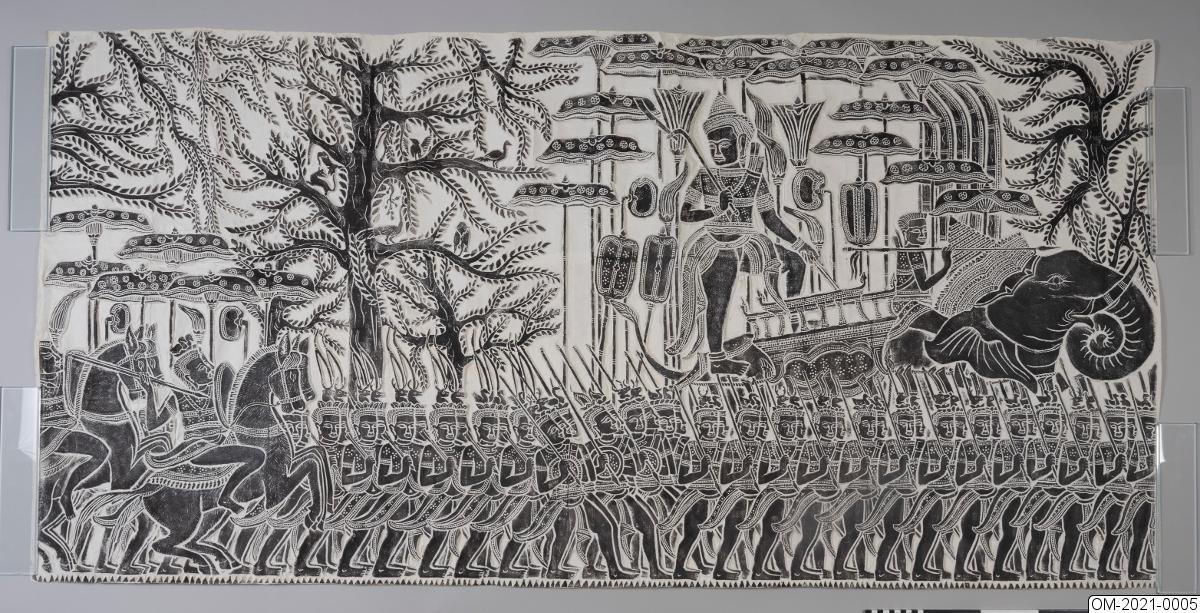| Typ <itemType> |
Objekt/föremål |
| Plats <presPlaceLabel> |
Asien, Kambodja |
| Beskrivning <itemDescription> |
-
Avklappningen daterar sig till 1960-tal.
Motivet här är sannolikt Kung Suryavarman II (ca. 1095 - ca. 1150, regent 1113 – ca. 1150) stående på sin elefant, centralt placerad i vad som benämnts ”Den historiska processionen”. För att markera kungens höga ställning avbildas denne omgiven av 15 parasoller, fem solfjädrar (av två typer), sex flugviskor (av två typer) och fem standar och elefanten bär ...
Visa hela
Avklappningen daterar sig till 1960-tal.
Motivet här är sannolikt Kung Suryavarman II (ca. 1095 - ca. 1150, regent 1113 – ca. 1150) stående på sin elefant, centralt placerad i vad som benämnts ”Den historiska processionen”. För att markera kungens höga ställning avbildas denne omgiven av 15 parasoller, fem solfjädrar (av två typer), sex flugviskor (av två typer) och fem standar och elefanten bär en kunglig huvudbonad.
Originalet till ”Den historiska processionen” utgörs av en sandstensrelief i templet Angkor Vat belägen i den västra avdelningen av det södra, yttre galleriet. Reliefpanelens totala längd är nästan 100 m. Med kungen i centrum leds varje föregående och efterföljande avdelning av en hög representant för provinser i kungens Suryavarman II rike. Reliefen daterar sig sannolikt till mitten av 1100-talet någon tid efter kungens död. En inskription med beskrivande text löper under reliefen.
Angkor Vat är Kung Suryavarman II mausoleum och kungen initierade bygget under sin regeringstid under första hälften av 1100-talet. Templet var helgat åt guden Vishnu, en gudom kungen ansågs vara en manifestation av och att ha förenats med vid sin död och var därför också ett tempel för tillbedjan av kungen. I inskriptionen benämns kungen med namnet Paramavisnuloka (Han som nått den Högste Vishnus rike).
Avklappningens centrala motiv överensstämmer med fotografiska avbildningar av reliefen i Angkor Vat, med kung Suryavarman II i denna scen, men detaljer i soldaternas huvudbonad samt placeringen av den nedre vänstra parasollen skiljer sig från dessa, och vidare saknas en parasoll till vänster. Fotografiska avbildningar visar också fyra standar medan avklappningen återger fem. Möjligen är avklappningen inte gjord efter originalreliefen.
Stäng
|
| Källor <itemDescription> |
-
George Coedès. 1963 [1947]. Angkor: An Introduction. Transl. E. Floyd Gardiner. Oxford University Press.
Albert le Bonheur. 1995. Of Gods, Kings, and Men: Bas-reliefs of Angkor Wat and Bayon. Serindia...
Visa hela
George Coedès. 1963 [1947]. Angkor: An Introduction. Transl. E. Floyd Gardiner. Oxford University Press.
Albert le Bonheur. 1995. Of Gods, Kings, and Men: Bas-reliefs of Angkor Wat and Bayon. Serindia Publications. London, sid. 20–21, 30.
Stäng
|
| Förvärvsomständigheter <itemDescription> |
|
| Anmärkning <itemDescription> |
|
| Land, engelska / ursprung <itemDescription> |
|
| Beskrivning, engelska <itemDescription> |
-
Rubbing from Angkor Wat
The rubbing dates from the 1960s.
The motif here is probably King Suryavarman II (ca. 1095 - ca. 1150, Regent 1113 - ca. 1150) standing on his elephant, in the centre of what h...
Visa hela
Rubbing from Angkor Wat
The rubbing dates from the 1960s.
The motif here is probably King Suryavarman II (ca. 1095 - ca. 1150, Regent 1113 - ca. 1150) standing on his elephant, in the centre of what has been called "The Historical Procession". To mark the King's high position, he is depicted surrounded by 15 parasols, five fans (of two types), six fly whisks (of two types) and five banners and the elephant wears a royal headdress.
The original of the "Historical Procession" is a relief located in the western part of the southern outer gallery of the temple Angkor Wat. The total length of the relief panel is almost 100 m. With the king in the centre, each previous and subsequent unit is led by a high representative of provinces in the kingdom. The relief probably dates to the middle of the 12th century, some time after the king's death. An inscription with descriptive text runs under the relief.
Angkor Wat is the mausoleum of King Suryavarman II and the king initiated the construction during his reign in the first half of the 12th century. The temple was dedicated to the god Vishnu, a deity the king was considered to be a manifestation of and to have united with at his death and was therefore also a temple for the worship of the king. In the inscription, the king is named Paramavisnuloka (He who reached the realm of the Supreme Vishnu).
The central motif of the rubbing is consistent with photographic depictions of the relief in Angkor Wat, with King Suryavarman II in this scene, but details in the soldiers' headdresses and the location of the lower left parasol differ from these, and furthermore a parasol is missing on the left. Photographic images also show four banners while the rubbing shows five. The rubbing may not have been done after the original relief.
Stäng
|
| Referens, källa <itemDescription> |
|
| Referens, källa <itemDescription> |
-
LeBonheur, Albert. & Poncar, Jaroslav. (red.) (1995). Of gods, kings, and men: bas-reliefs of Angkor Wat and Bayon. London: Serindia Publ.
|
| Händelse <context> |
-
Ursprung i Kambodja, Asien.
-
Insamlad 1967 .
-
Förvärvad 2010 av Myrdal, Jan.
|
| Material, engelska<itemMaterial> |
- paper
|
| Material<itemMaterial> |
- papper
|
| Nyckelord <itemKeyWord> |
-
paper
-
rubbing
-
Angkor Wat
-
OM-2021-0005
-
Sydostasien
-
paper
-
종이 紙
|
| Motiv <itemMotiveWord> |
-
Kung Suryavarman II
-
elefant
-
hästar
|
| Sakord<itemName> |
- avklappning
|
| Ämne <subject> |
|
| Accessionsnummer <itemNumber> |
|
| Rättigheter för metadata <itemLicense> |

|
| Källa <presOrganization> |
Statens museer för världskultur - Östasiatiska museet |
|
Källa <url>
|
|















 ARTIKLAR I WIKIPEDIA
ARTIKLAR I WIKIPEDIA ARTIKLAR I WIKIDATA
ARTIKLAR I WIKIDATA BILDER I WIKIMEDIA COMMONS
BILDER I WIKIMEDIA COMMONS





